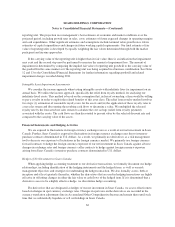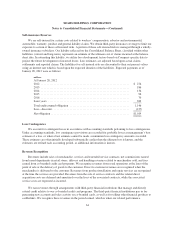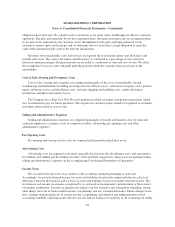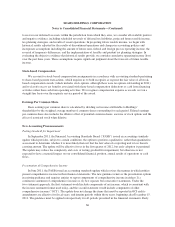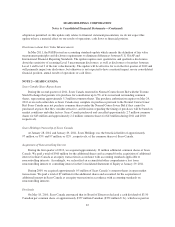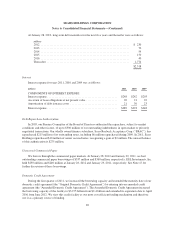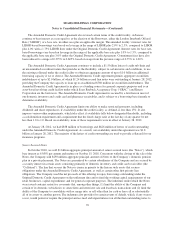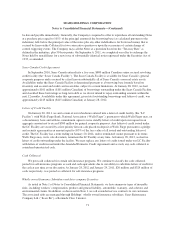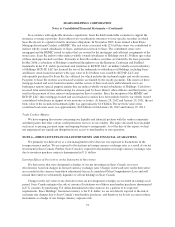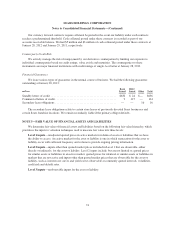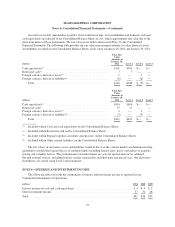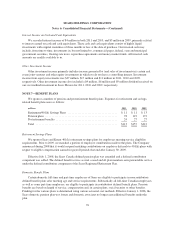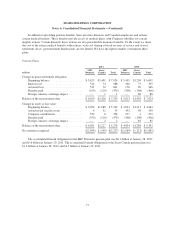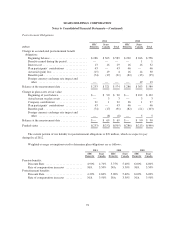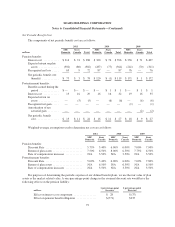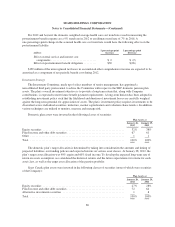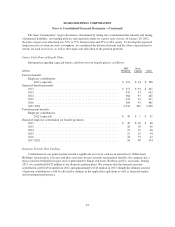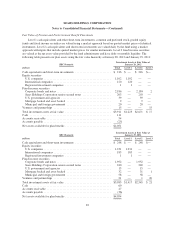Sears 2011 Annual Report Download - page 72
Download and view the complete annual report
Please find page 72 of the 2011 Sears annual report below. You can navigate through the pages in the report by either clicking on the pages listed below, or by using the keyword search tool below to find specific information within the annual report.SEARS HOLDINGS CORPORATION
Notes to Consolidated Financial Statements—(Continued)
In accordance with applicable insurance regulations, Sears Re holds marketable securities to support the
insurance coverage it provides. Sears utilizes two securitization structures to issue specific securities in which
Sears Re invests its capital to fund its insurance obligations. In November 2003, Sears formed a Real Estate
Mortgage Investment Conduit, or REMIC. The real estate associated with 125 full-line stores was contributed to
indirect wholly owned subsidiaries of Sears, and then leased back to Sears. The contributed stores were
mortgaged and the REMIC issued securities that are secured by the mortgages and collateral assignments of the
store leases. Sears Re and two other indirect wholly owned subsidiaries of Holdings own $1.3 billion (par value)
of these mortgage-backed securities. Payments to Sears Re on these securities are funded by the lease payments.
In May 2006, a subsidiary of Holdings contributed the rights to use the Kenmore, Craftsman and DieHard
trademarks in the U.S. and its possessions and territories to KCD IP, LLC, an indirect wholly owned subsidiary
of Holdings. KCD IP, LLC has licensed the use of the trademarks to subsidiaries of Holdings, including Sears
and Kmart. Asset-backed securities with a par value of $1.8 billion were issued by KCD IP, LLC and
subsequently purchased by Sears Re, the collateral for which includes the trademark rights and royalty income.
Payments to Sears Re on these asset-backed securities are funded by the royalty payments. The issuers of these
mortgage-backed and asset-backed securities and the owners of these real estate and trademark assets are
bankruptcy remote, special purpose entities that are indirect wholly owned subsidiaries of Holdings. Cash flows
received from rental streams and licensing fee streams paid by Sears, Kmart, other affiliates and third parties, are
used for the payment of fees, interest and principal on these securities. Since the inception of the REMIC and
KCD IP, LLC, these mortgage-backed and asset-backed securities have been entirely held by our wholly owned
consolidated subsidiaries in support of our insurance activities. At January 28, 2012 and January 29, 2011, the net
book value of the securitized trademark rights was approximately $1.0 billion. The net book value of the
securitized real estate assets was approximately $0.8 billion at both January 28, 2012 and January 29, 2011.
Trade Creditor Matters
We have ongoing discussions concerning our liquidity and financial position with the vendor community
and third parties that offer various credit protection services to our vendors. The topics discussed have included
such areas as pricing, payment terms and ongoing business arrangements. As of the date of this report, we had
not experienced any significant disruption in our access to merchandise or our operations.
NOTE 4—DERIVATIVE FINANCIAL INSTRUMENTS AND FINANCIAL GUARANTEES
We primarily use derivatives as a risk management tool to decrease our exposure to fluctuations in the
foreign currency market. We are exposed to fluctuations in foreign currency exchange rates as a result of our net
investment in Sears Canada. Further, Sears Canada is exposed to fluctuations in foreign currency exchange rates
due to inventory purchase contracts denominated in U.S. dollars.
Earnings Effects of Derivatives on the Statements of Operations
For derivatives that were designated as hedges of our net investment in Sears Canada, we assess
effectiveness based on changes in forward currency exchange rates. Changes in forward rates on the derivatives
are recorded in the currency translation adjustments line in Accumulated Other Comprehensive Loss and will
remain there until we substantially liquidate or sell our holdings in Sears Canada.
Changes in the fair value of any derivatives that are not designated as hedges are recorded in earnings each
period. Sears Canada mitigates the risk of currency fluctuations on offshore merchandise purchases denominated
in U.S. currency by purchasing U.S. dollar denominated collar contracts for a portion of its expected
requirements. Since Holdings’ functional currency is the U.S. dollar, we are not directly exposed to the risk of
exchange rate changes due to Sears Canada’s merchandise purchases, and therefore we do not account for these
instruments as a hedge of our foreign currency exposure risk.
72


